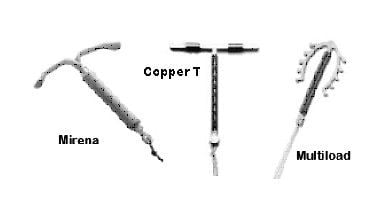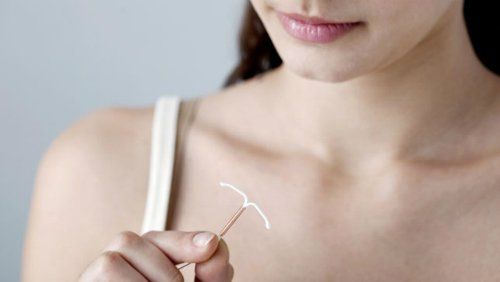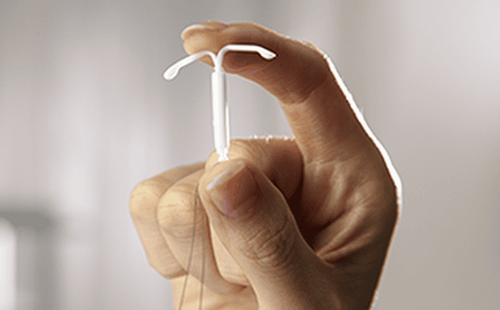This is an automatically translated article.
The IUD has long been used as an effective birth control method for women after giving birth. The principle of IUD insertion is very simple, the operation time is fast. However, many women are often worried with the long-term effect, whether long-term IUD will have any effect.
1. Overview of IUD insertion
IUD is placing a small T-shaped device and made of plastic into a woman's uterus, to prevent the meeting between sperm and egg, thereby helping to prevent fertilization and the fetus develops in the uterus.
There are two types of IUDs commonly used, the copper T-ring and the hormonal IUD.
Copper-containing T-IUD: Copper-containing IUDs have a long duration of action, up to 10 years. After the copper IUD is inserted, immediate contraception is possible, so there is no need to abstain from sex. However, the downside of copper IUDs is that it can cause menstrual disorders, lower abdominal pain and sensitization in women who are allergic to copper. Hormonal IUD: In addition to preventing pregnancy, the hormonal IUD also works to regulate menstruation without causing side effects such as lower abdominal pain. However, the duration of action of the hormonal ring is shorter than that of the copper IUD, only about 3-5 years. This type of IUD is more expensive. The disadvantage of the hormonal ring is that it can cause weight gain, acne, amenorrhea or amenorrhea, ... Therefore, to ensure health safety as well as promote the effect of the IUD, women You should research carefully and have a gynecological examination before deciding to insert an IUD.

Có nhiều loại vòng tránh thai khác nhau
2. Principle of IUD insertion
Principle of IUD insertion works as follows, after being placed in the uterus, the IUD will affect the lining of the uterus to prevent sperm and egg from meeting, fertilization and implantation also not formed and developed.
In order to put an IUD with high efficiency, and at the same time limit the side effects that affect women's health, it is necessary to note the time of IUD insertion as follows:
After the period ends and there is no intercourse sex. After giving birth normally 6 weeks and not having sex. If you are menstruating, you should wait until your period stops before you put on the IUD. After menarche returns and menstruation stops, in case of abortion or miscarriage. At least 3 months after the cesarean section, when the incision is completely healed and other birth control methods have been used but have not been effective.
Trắc nghiệm: Bạn đã biết cách tránh thai an toàn chưa?
Có rất nhiều biện pháp tránh thai an toàn nhưng không phải ai cũng biết được điều đó. Trả lời đúng những câu hỏi trắc nghiệm dưới đây chứng tỏ bạn có kiến thức tốt về các biện pháp ngừa thai an toàn.3. Does long-term IUD have any effect?
Among contraceptive methods, IUD is a method with many advantages such as:
High effectiveness in preventing pregnancy (>97%), immediate effect. The duration of action is long (from 3 to 5 years or up to 10 years depending on the type of ring). The sex life of the couple is not affected when the IUD is inserted. A woman's ability to become pregnant and give birth is not affected, when she wants to become pregnant and have another child, she only needs to see a gynecologist to have the IUD removed. The ring can be inserted while breastfeeding because it does not affect lactation.

Đặt vòng tránh thai là phương pháp ngừa thai hiệu quả và an toàn
With the above advantages, women can completely rest assured to put on a long-term IUD without affecting reproductive health. However, after placing the ring, some side effects may occur in a short time such as:
Lower abdominal pain if the ring is displaced (due to sex, heavy labor, ...) or the ring is inserted. unsuitable. Menorrhagia, heavy bleeding, amenorrhea or amenorrhea. Hormonal disturbances cause menstrual disorders, mood swings, skin pigmentation, acne, breast tightness, ... Increased vaginal discharge, vaginal discharge after IUD insertion. These side effects are usually short-lived as the body gets used to the IUD. Once acclimatized, the symptoms will gradually disappear. In case the symptoms do not improve, women should visit a medical facility or gynecologist soon to be examined and remove the ring if necessary.
4. The IUD is not suitable for whom?
In the following cases, an IUD can be inserted:
Pregnant women who do not know or have suspected signs of pregnancy. Women with uterine fibroids, cervical cancer, ovarian cancer, pelvic inflammatory disease or other malignancies of the genital tract. Women with gynecological inflammation, genital tract infections. Women with birth defects of the uterus. Women with acute anemia, hemorrhage. Women who have abortions or abortions.

Phụ nữ bị di tật tử cung bẩm sinh cũng có thể đặt vòng tránh thai
5. IUD insertion and things to note
The steps to place an IUD are as follows:
Step 1: The doctor consults and examines and examines gynecological health. Step 2: The doctor determines the size of the uterus and the position to place the ring, selects the IUD suitable for the size. Step 3: The doctor cleans and cleans the vagina. Step 4: The doctor folds small and places the selected ring into the piston tube, then inserts the piston into the cervix, gently pushes the piston to place the IUD into the woman's uterus. Step 5: After the ring is inserted into the uterus, it will open in a T-shape. The doctor pulls out the piston tube and cuts a piece of wire of the ring, this wire works to check if the ring is displaced or not. lost or not. Women, if they ensure that they do not have an infection or have been treated for sexually transmitted diseases, when the IUD is placed, it will take place very smoothly, safely and quickly. 10 minutes.
After placing the ring, women should note the following information:
Lie down and rest in place for 30 - 60 minutes right after placing, so that the doctor can promptly handle if the ring is not suitable. Light activity, light work, reasonable rest 5-7 days after the ring is placed. Limit sexual activity between husband and wife 7-14 days after IUD insertion.

Hạn chế quan hệ tình dục trong khoảng 1-2 tuần sau khi đặt vòng
After each menstrual period, it is necessary to check the ring wire. If you see symptoms such as prolonged lower abdominal pain, menstrual disorders, abnormal discharge, vaginal bleeding, ... you should immediately go to a medical facility for examination and examination. Having a long-term IUD does not affect the reproductive health in particular and the health of women in general. It is a safe, effective, long-acting and low-cost birth control method.
Vinmec International General Hospital is the address for examination, treatment and prevention of diseases, including Obstetrics and Gynecology. When performing the examination process at Vinmec, customers will be welcomed and used modern facilities and equipment along with perfect medical services under the guidance and advice of experts. Good doctors, well-trained both at home and abroad.
Therefore, if women have fertility problems or need in-depth advice on appropriate contraceptive methods, they can go to Vinmec Health system nationwide for examination or contact the hotline for advice. support.
Please dial HOTLINE for more information or register for an appointment HERE. Download MyVinmec app to make appointments faster and to manage your bookings easily.













